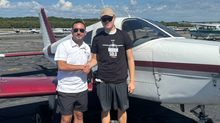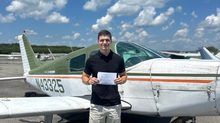Angle of Attack Indicators
- Feb 18, 2016
- 3 min read
AoA indicators are certainly cool widgets, and for night flight and actual instrument conditions they are wonderful at improving situation awareness on approach to landing.
However, I think that the fundamental issue is pilot training. While it takes more training to obtain a pilot certificate than a drivers license, it's still usually lacking.
When I conduct flight reviews there are two major trends that seem to follow most pilots.
1) A lack of understanding of angle of attack. By this, most pilots can describe angle of attack in flight on some level and know that when you reach the critical angle of attack the airplane will stall and that load factor can have some sort of effect on stall speed. But when asked to explain what exactly is going on with pitch attitude during approach to landing, many pilots stumble to get out that pitch controls airspeed, and sadly many times pilots I ask this question have come to decide power sets their airspeed on approach.
2) A lack of knowledge on use of their aircraft avionics and other systems. GA pilots are notorious for flying once ever 24 months with an instructor that they are usually familiar with for an hour and grabbing lunch. This is a disservice to the pilot being flight reviewed, and any other being that they decide to take for a flight after they are good to go for another 24 months. Many pilots that I encounter during flight reviews who own their own aircraft pride themselves on having the latest gadgets and widgetry in their aircraft to the most high tech electronic flight bags. However, when it comes to actually using these devices, their knowledge is usually lack luster at best. They can use each item individually to some level, but when it comes to using all of their equipment as one cohesive "system" too much hunt-and-peck usually ensues at critical times of flight. Ex. Approaching the traffic pattern, setting up or entering an approach, or on final approach.
Taking off and Landing in all flight conditions in GA is a visual affair, you need to have the actual runway in sight while executing the appropriate landing procedure. As AoA indicators have started to become more common in GA aircraft, I notice many pilots will start watching them on short final. A time when it is absolutely critical that as much attention as possible is outside of the aircraft to watch for obstacles on the runway, other aircraft, wind corrections, drones, birds or even hazardous runway conditions.
Once you have an AoA indicator installed, it should be integrated into the use of your entire aircraft system. Meaning that after you use it once to obtain a certain angle of attack on approach or level flight you should be able to visually identify that from then on without having to constantly reference your AoA indicator. This same statement holds true for takeoff in light GA aircraft, watching an AoA indicator on rotation and climb out will prevent you from seeing that no radio using, flock of birds that is quickly approaching from 12 o'clock.
Maintaining a stabilized approach is important, if a glance at an AoA indicator on final approach is something that you feel you need to do, you should integrate it into your scan but not fall into the trap of trying to make pitch changes based on what the AoA indicator is showing at that exact time.
If you're flying visually you should use the outside references, if you're flying instruments then you should go back to your instrument scan and use your attitude indicator to make the pitch adjustment and verify it with your AoA indicator.
We operate in an environment where one of the keys to constant improvement is recognition of poor sloppy procedure and the humility to constantly seek improvement in that area are the contributors to constant improvement. None of us are as good as we think, and can all improve.
If an AoA indicator is something you want, you should get it. Is it something you need? Maybe, maybe not.
It is important that if you do decide to add one of these devices to your system, that you seek out training to verify that your implementation of it to your operational procedures is the best practice possible.












































